先日、カナダとアメリカの国境近くに住む Bernie さんから、こんなメールを受け取りました。
The other day I got an e-mail from Mr. Bernie Crawley (who lives near the border of Canada and the U.S.), which reads:
Hello. Enjoyed your website, great job.
こんにちは。あなたのサイト 楽しませてもらいました。
I just picked up a sleeve, (no disc I’m afraid) to a Buddy Rich 10 inch I think.
ところで、Buddy Rich の10インチ盤用に作られたと思われるスリーヴを入手しました(残念だけど盤はなくてスリーヴ単体でした)。
It is part of the “Mercury Records Popular Autographed Photograph Series“, the back of the sleeve has a bio, similar to what you might find on a long player. There is no mention of a catalogue number & I’m not sure if it was a 78 or a 10” LP.
それは「Mercury Records Popular Autographed Photograph Series」の1枚らしく、スリーヴ裏にはバイオグラフィーが書かれていて、ちょうどLPの裏ジャケみたいになっています。スリーヴにはカタログ番号は書かれておらず、これが78回転盤用のスリーヴなのか、10インチLP用のスリーヴなのかもわかりません。
Have you seen one of these before? Any ideas?
このようなスリーヴを過去に目にしたことはありますか? なにかご存知のことはありますか?
Email I got from Bernie Crawley on May 11, 2023私もそのようなスリーヴの存在を知りませんでしたし、ネット上であれこれ検索してもまったく情報がありませんでした。ともあれ、その後もメールのやりとりを続けて情報交換をしました。
No, I have never seen such sleeves before. Furthermore, no matter how much I searched on the web, I couldn’t find any information on the “Mercury Popular Autographed Photograph Series”. Anyway I tried to keep in touch with him, and had shared several information.
Contents / 目次
The “Popular Autographed Photograph Seires” Sleeve
最終的に、「eBay に出品しようと思っているが、もし必要ならお譲りしても構わない」という Bernie さんの申し出で、値段交渉の末、そのみたこともきいたこともないスリーヴを入手しました。
Finally, Mr. Crawley told me that, he was going to sell it on eBay, but if I wanted it he would gladly sell it directly to me. So we negotiated the price, then I could obtain the one-of-a-kind sleeve.
それがこちらです。スリーヴ表の Buddy Rich さん、若いですね。
And here is the sleeve — how young and fresh Mr. Buddy Rich looks on the front cover!
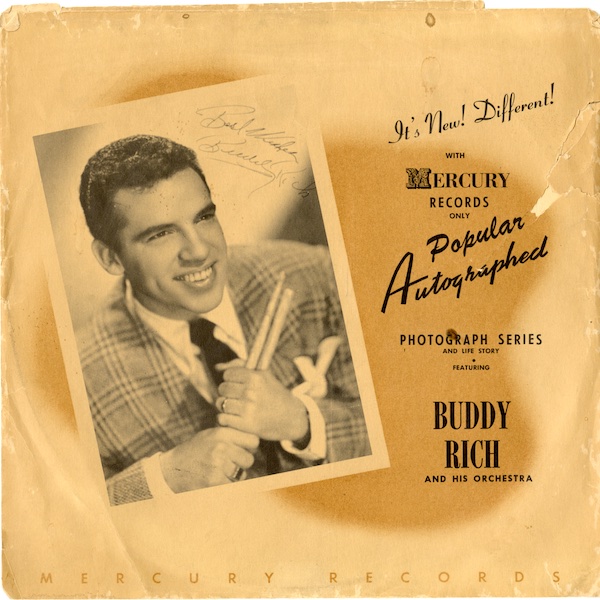
Mercury Popular Autographed Photograph Series (feat. Buddy Rich) Sleeve, Front
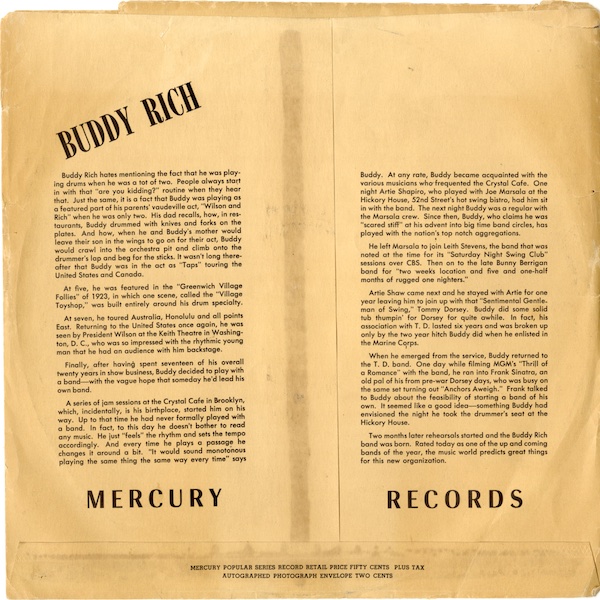
Mercury Popular Autographed Photograph Series (feat. Buddy Rich) Sleeve, Back
現物をすみずみまで確認して、ピン!ときました。Mercury と Buddy Rich が契約していたのは 1946年ですから、これは間違いなく 78回転盤用に特別に作られた、1946年製造のスリーヴ です。当時 Mercury から出された Buddy Rich の 78回転盤は、以下の8枚です。これらは 1946年2月5日、4月25日、9月10日の3セッションで録音された音源です。
I carefully checked the sleeve (envelope) itself — and Eureka! it’s definitely a special sleeve for 78rpm records, and this is definitely from 1946, because Mercury and Buddy Rich had a recording contract in 1946. As many as eight 78 rpm records by Buddy Rich and His Orchestra were released as follows — these tracks were from the sessions on February 5, April 25 and September 10, 1946.
2060: You've Got Me Crying Again c/w Desperate Desmond (soon reissued as Mercury 3012)
2068: It Couldn't Be True c/w Dateless Brown (soon reissued as Mercury 3001)
3001: It Couldn't Be True c/w Dateless Brown (reissue of Mercury 2068)
3012: You've Got Me Crying Again c/w Desperate Desmond (reissue of Mercury 2060)
3017: Quiet Riot c/w Baby, Baby All The Time
3025: Route 66 c/w The Iggidy Song
3037: Ready To Go Steady c/w Oop Bop Sh' Bam
3038: It's About Time c/w Rich-ual Dance
ディスコグラフィー的に表記すると、こんな感じです。
“Discographical” notation of these Mercury recording would be something like this:
Buddy Rich and His Orchestra:
Bitsy Mullens, Paul Cohen, Jimmy Pupa, Carl Warwick (tp),
Sam Hyster, Johnny Mandel, Earl Swope (tb),
Les Clarke (as), Romeo Penque (as, cl),
Mike Blanos, George Berg (ts), Sid Brown (bars),
Tony Nichols (p), Lenny Mirabella (g), Joe Shulman (b), Buddy Rich (ds),
Dorothy Reid (vo).
Recorded in NYC, February 5, 1946.
213 Dateless Brown Mercury 2068, 3001, 5022, EmArcy EMS-2-402
214 You Got Me Crying Again Mercury 2060, 3012
215 Desparate Desmond Mercury 2060, 5022, EmArcy EMS-2-402
216 It Couldn't Be True Mercury 2068, 3001
Buddy Rich and His Orchestra:
Bitsy Mullens, Tommy Allison, Lou Oles, Pinky Savitt (tp),
Al Lorraine, Johnny Mandel, Earl Swope (tb),
Les Clarke (as), Aaon Sachs (as, cl),
George Berg, Mickey Rich (ts), Sid Brown (bars),
Tony Nichols (p), Jimmy Johnson (b), The Woodchucks (vo).
Recorded in NYC, April 25, 1946.
361 Quiet Riot Mercury 3017, EmArcy EMS-2-402
362 Baby, Baby All The Time Mercury 3017, 5224
363 Route 66 Mercury 3025
364 The Iggidy Song Mercury 3025
Buddy Rich and His Orchestra:
Bitsy Mullens, Red Rodney, Tommy Allison, Pinky Savitt (tp),
Johnny Mandel, Earl Swope, Al Lorraine (tb),
Les Clarke, Jerry Thirlkild (as), George Berg, Mickey Rich (ts),
Sid Brown (bars),
Tony Nichols (p), Jimmy Johnson (b), Buddy Rich (ds,vo), Stanley Kay (ds),
Dorothy Reid (vo)
Recorded in NYC, September 10, 1946.
530 It's About Time Mercury 3038, 5043
531 Ready To Go Steady Mercury 3037, 5224
532 Rich-ual Dance Mercury 3038, 5043
532 Rich-ual Dance (alt. take) Verve 314 525 517-2
533 Oop Bop Sh' Bam Mercury 3037, EmArcy EMS-2-402
ちなみに、これらの音源のうち4曲は、1976年リリースの2枚組LP “Both Sides” (EmArcy EMS-2-402) としてもリリースされました。
For your information, four of these tracks were included in the double LP release “Both Sides” (EmArcy EMS-402), released in 1976.
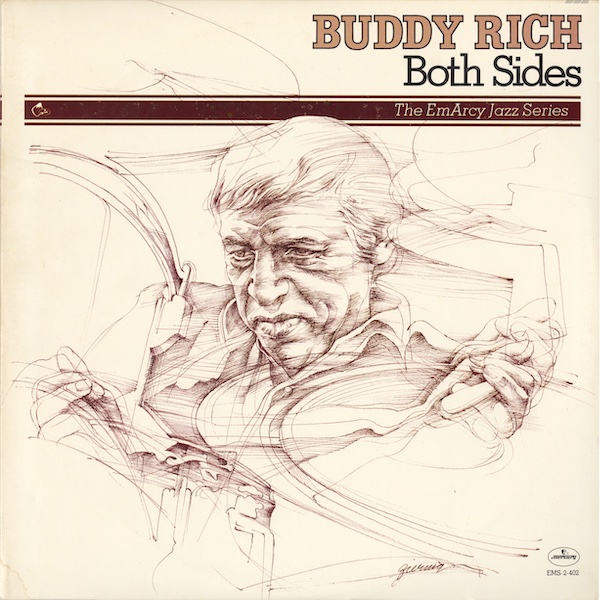
また、有名なシリーズ Chronological Classics でも、1999年リリースの CD “Buddy Rich and His Orchestra 1946-1948” (Classics 1099) として全曲聴くことができます。
Also, the 1999 CD of “Buddy Rich and His Orchestra 1946-1948” (Classics 1099), from the famous Chronological Classics series contains all of these tracks by Buddy Rich on Mercury.

Spotify にも、Buddy Rich のこの時期の音源をまとめたアルバムがあるのを見つけました。
Also, I found the compilation album of Buddy Rich’s 1946-1948 recordings.
The Billboard, July 20, 1946: “Mercury Means Business”
そして、上記の推測にあわせて調べまくったら、この特製ピクチャースリーヴに関係する当時の雑誌広告を見つけることができました。
So, based on my inference and hypothesis, I googled a few more in detail — then Bingo! I could find the magazine ad which surely is related to this particular sleeve.
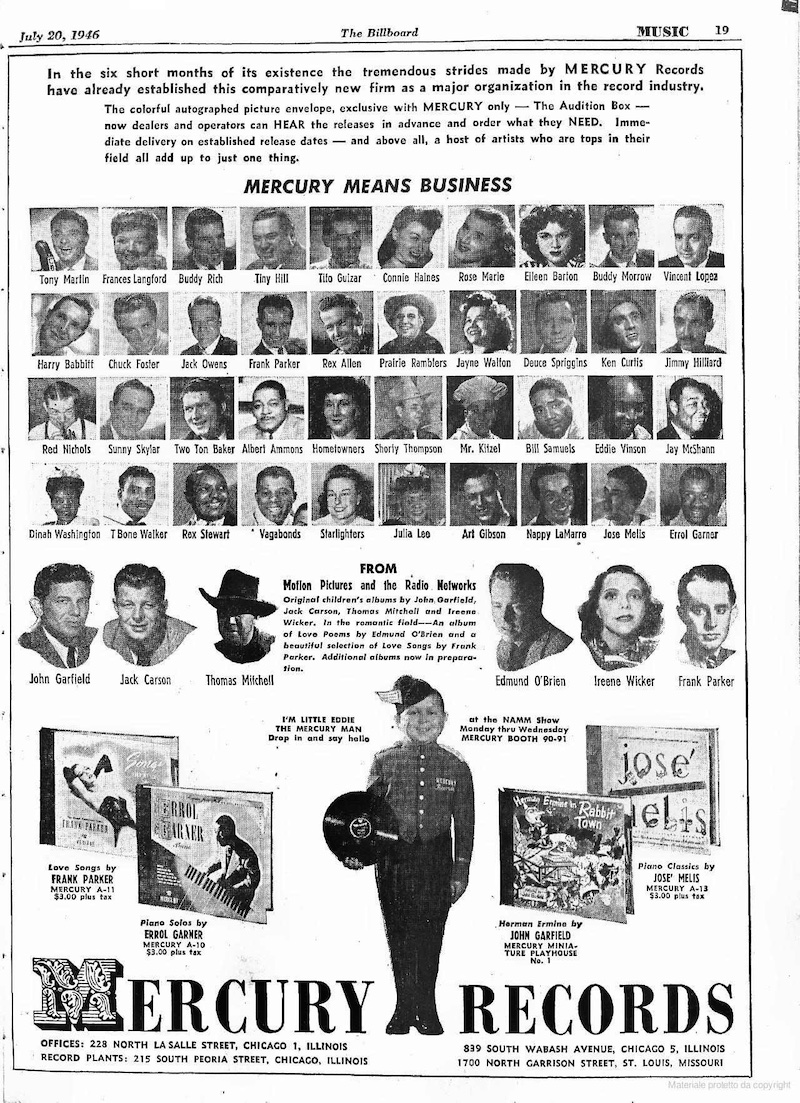
source: “Mercury Means Business”, The Billboard, Vol. 58, No. 29, July 20, 1946, p.19.
サイン入り写真が印刷されたスリーブについて触れられている広告
この広告の上に書かれている説明には、こうあります。
The description on the top of the ad reads:
In the six short months of its existence the tremendous strides made by MERCURY Records have already established this comparatively new firm as a major organization in the record industry.
設立から半年という短い期間で Mercury Records は躍進を遂げ、この比較的新しい会社を、レコード業界のメジャー組織として確立させました。
The colorful autographed picture envelope, exclusive with MERCURY only — The Audition Box — now dealers and operators can HEAR the releases in advance and order what they NEED. Immediate delivery on established release dates — and above all, a host of artists who are tops in their field all add up to just one thing.
カラフルなサイン入り写真があしらわれたスリーヴは、Mercury 独自の「オーディションボックス」にのみ収録されます。これにより、ディーラーや(ラジオ局の)オペレータは音源をリリース前に試聴でき、必要なものだけ注文できます。そしてリリース日に即納されます。そしてなにより、各界のトップアーティストが揃っています。
“Mercury Means Business”, The Billboard, Vol. 58, No. 29, July 20, 1946, p.19Mercury’s unique promotion
1945年10月頃にリリース開始したシカゴの新興レーベル Mercury Records は、優れたA&Rによりヒット性の高いアーティストと次々契約、他の主要レーベルがラジオ放送による販促を主とするなか、プロモーションコストを下げるべくジュークボックス市場を中心に開拓、所有する2箇所の自社プレス工場では週に70万枚プレス可能とし、あっという間に準メジャーの地位を獲得しました。
Emerging from Chicago, Mercury Records was a fresh independent label that launched its first records in October 1945. This promising company successfully established contracts with numerous talented artists, opting to reduce costs by promoting its records through jukebox distributors instead of relying heavily on radio airplay, as many major labels did. With the capacity to press 700,000 disks weekly at their two record pressing plants, Mercury swiftly carved out a spot for itself as a semi-major label in the music industry.
そして次に、レコード販売店やラジオ局を狙って販促を行う際に使われたのが、このスリーヴということになりそうです。表には Mercury が当時売り出し中のアーティストのサイン入り写真が印刷され、裏には、まるでのちのLP時代を想起させるように、そのアーティストのバイオグラフィーが印刷されているものです。
As Mercury initiated another unique promotional strategy targeting record dealers and radio DJs, it’s likely they incorporated the use of “autographed photograph” sleeves. These sleeves displayed a printed autograph of the artist on the front, not an actual signed photograph, complemented by a brief biography on the back. This format bears a striking resemblance to the jacket design employed for later LP releases.
スリーブ裏の一番下には価格も書かれており、「Mercury Popular Series」の盤自体は50セント(税別)、そしてこのスリーヴが2セント、とされています。
Another interesting thing is the price of the sleeve and the record, printed on the bottom of the back sleeve: “Mercury Popular Series” disk itself costs 50 cents (plus tax); and this “Autographed Photograph” sleeve itself being 2 cents.

Possible disk(s) inside the Autographed Photograph sleeve?
レーベル開始直後は 2000番台のリリースが行われていましたが、このスリーヴに書かれた「Mercury Popular Series」というのは、1946年頃からリリースされた 3000番台 のことを指します。つまり、今回の Buddy Rich のスリーヴの場合は、私の手元にある盤で言うと、例えば次のような盤が封入されていた可能性が高いことになります。
Mercury’s initial releases were from the 2000 series immediately after the label’s start, but the term “Mercury Popular Series” written on this sleeve refers to the 3000 series, which started around 1946. In other words, in the case of this particular Buddy Rich’s “Popular Autographed Photograph Series” sleeve, it’s highly probaly that a record such as the one shown below from my collecion would have been included.
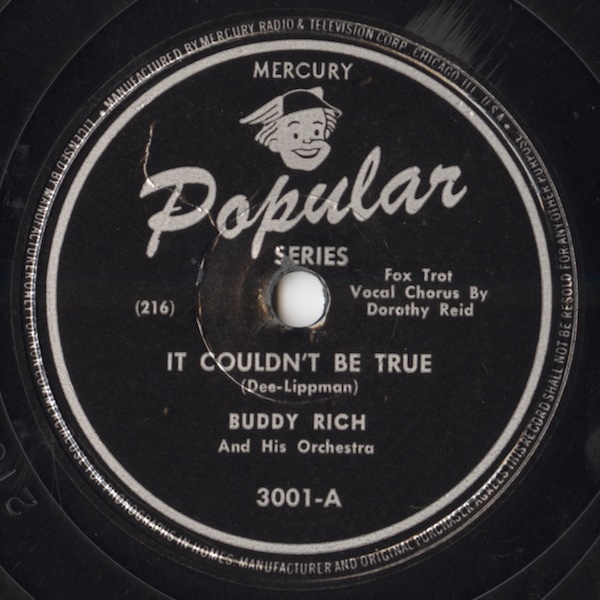
Mercury 3001-A “It Couldn’t Be True” / Buddy Rich and His Orchestra
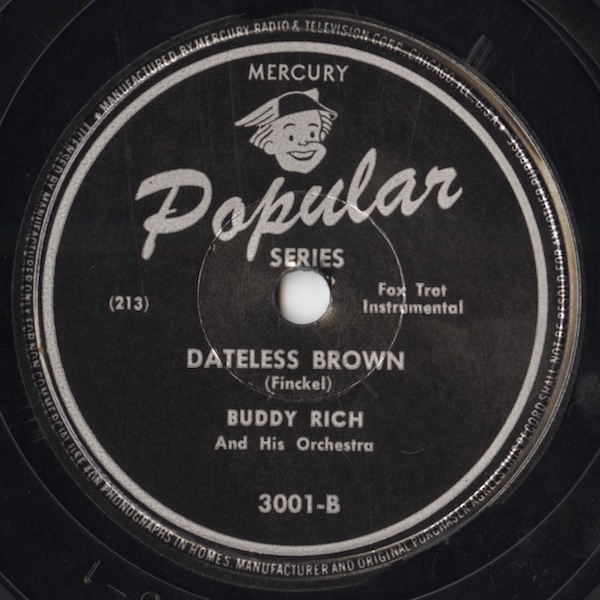
Mercury 3001-B “Dateless Brown” / Buddy Rich and His Orchestra
実は、この Mercury 3001 は、実はセカンドリリースで、オリジナルは 2000番台の Mercury 2068 です。2000番台のレーベルデザインと3000番台のレーベルデザインはかなり異なることが分かります。
Actually, Mercury 3001 was a second release: the original issue was Mercury 2068. The label designs of 2000 Series and 3000 Series are much different each other.
ちなみに、この頃の盤は、販売店で市販される場合には、いわゆるカンパニースリーヴに入れられていました。この時期に合致する Mercury のカンパニースリーヴは以下のタイプです。社名が “Mercury Records” ではなく、“Mercury Radio annd Television Corporation” となっているのが特徴で、上の Billboard 広告にも登場していた当時の販促マスコット「Mercury Man」のイラストがあしらわれています。
By the way, around 1946, Mercury’s 78rpms for consumers were sold in what are known as “company sleeves.” The company sleeves accompanying Mercury disks in 1946 should look like the following — you’ll notice that the company name is not “Mercury Records,” but “Mercury Radio and Television Corporation“. Also, illustrations of the “Mercury Man” (as previously seen in the above Billboard ad) are printed on the company sleeve.
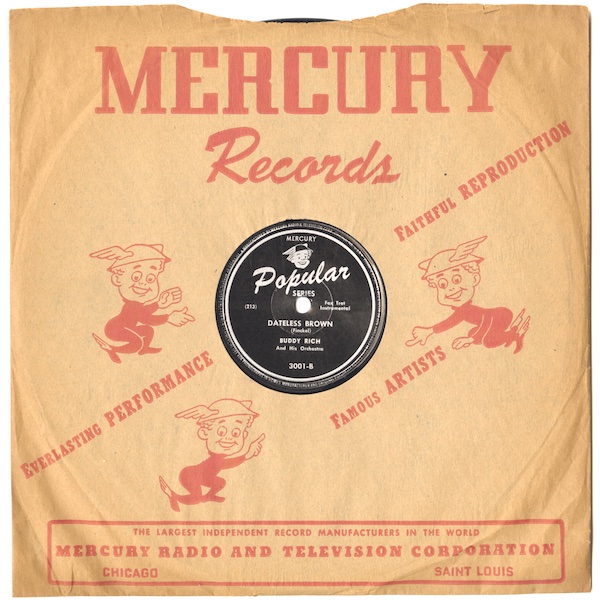
“It Couldn’t Be True c/w Dateless Brown” by Buddy Rich (Mercury 3001), with company sleeve
About the “Mercury Man”
以下余談です。広告にも出てきた「Mercury Man」についての小話です。
As an aside, here’s a little story about the “Mercury Man”, who also appeared in a Billboard magazine advertisement.
1946年6月、レーベル発足1年にも満たない Mercury は、販促のために Eddie Gaedel を起用します。
In June 1946, Mercury hired Eddie Gaedel in order to help promote their records.
Gaedel 氏は、AGVA (American Guild of Variety Artists, 全米バラエティショー芸人組合) 所属の芸人で、身長3フィート7インチ (107cm) でした。この彼に天使の羽のようなものがついた帽子を被せスーツを着せて「Mercury Man」として起用、写真やイラストで Mercury の広告などで活躍することになります。
Interestingly, Mr. Gaedel was a professional perfomer belonging to AGVA (American Guild of Variety Artists), only 3 feet and 7 inches tall. His costume “was a suit with a pair of angel wings on the back”, which became the Mercury logo at the time — the “Mercury Man”.

source: “A Little Idea That Worked”, The Billboard, Vol. 84, No. 22, Mercury 25th Anniversary, p. M-23.
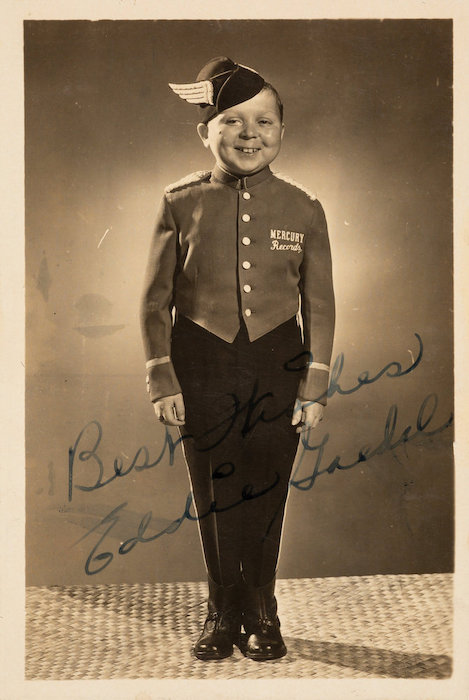
source: “Circa 1946 Eddie Gaedel Signed Real Photo Postcard”, Heritage Auctions.
Eddie Gaedel as a “smallest” Major Leaguer
のちにセントルイスブラウンズのオーナ Bill Veeck が彼を発掘し契約、背番号「1/8」をつけ、ダブルヘッダーの間のアトラクションなどに登用したそうです。
Subsequently, St. Louis Browns’ owner Bill Veeck found him and signed a contract. Mr. Gaedel’s uniform number was “1/8”, and he appeared on the attractions between the games.
そして1951年8月19日の対デトロイトタイガースとのダブルヘッダー第2試合1回裏、代打Gaedelバッターボックスへ。球審Ed Hurleyはどういうことだと問い詰めますが、選手登録も契約もあり、試合はそのまま続行。
Then on August 19, 1951, Mr. Gaedel entered the second half of the doubleheader between the St. Louis Browns and Detroit Tigers in the bottom of the first inning, as a pinch hitter. “Immediately, umpire Ed Hurley called for Browns manager Zack Taylor. Veeck and Taylor had the foresight to have a copy of Gaedel’s contract on hand, as well as a copy of the Browns’ active roster, which had room for Gaedel’s addition. (from Wikipedia)”.
バットを1回も振ることなく四球で出塁、ピンチランナーのJ im Delsing に交代、これが唯一のメジャーリーグ出場となりました。実際には、球団オーナのBill Veeckから、生命保険1万ドルかけてるから、もしバッターボックスでバットを振る素振りを見せようもんならスナイパーに射殺させるぞ、と脅されていた、とのことです。
However, he didn’t even swing one, result in four consecutive balls. He took the base, and was replaced by a pinch-runner Jim Delsing. This weird event was Mr. Gaedel’s only appearance at major baseball games. The fact was that, “Gaedel was under strict orders not to attempt to move the bat off his shoulder. When Veeck got the impression that Gaedel might be tempted to swing at a pitch, he warned Gaedel that he had taken out a $1 million insurance policy on his life, and that he would be standing on the roof of the stadium with a rifle prepared to kill Gaedel if he even looked like he was going to swing (from Wikipedia)”.
Eddie Gaedel wore number "1/8" on his St. Louis Browns jersey for his only MLB at bat (August 19, 1951) @UniWatch pic.twitter.com/vJo2DaDY6J
— Baseball by BSmile (@BSmile) August 19, 2016
以上、私はメジャーリーグベースボールに全然詳しくないのですが、Mercury とメジャーリーグの歴史が、まさかこんな風につながっているとは思いませんでした。
I am not an expert or a fan of Major League Baseball at all, but I am so surprised and impressed to know that there was an inevitable connection between Mercury Records (and the “Mercury Man”) and the history of Major League Baseball.




